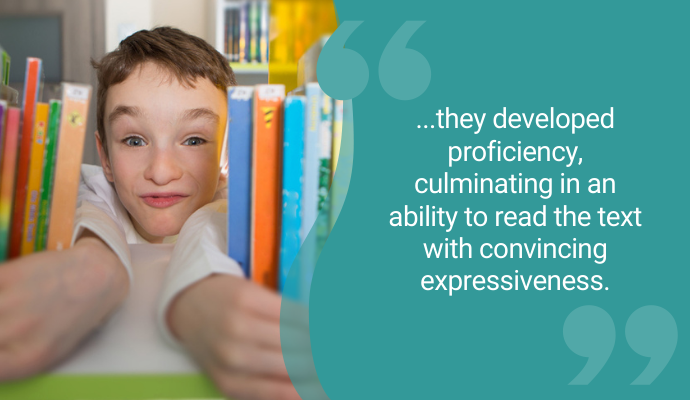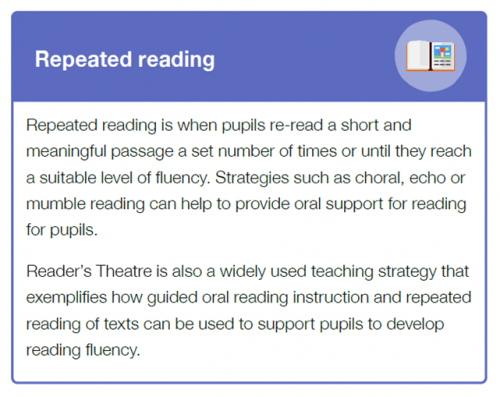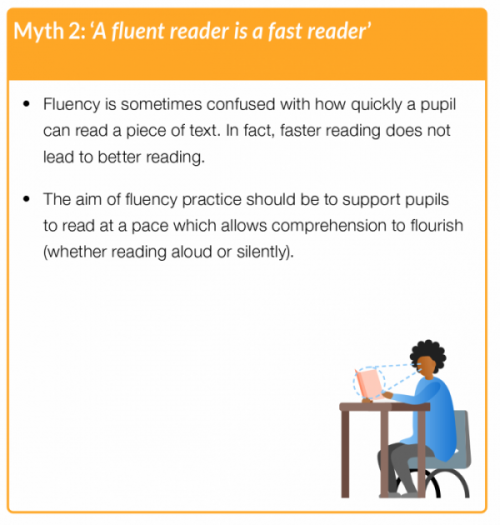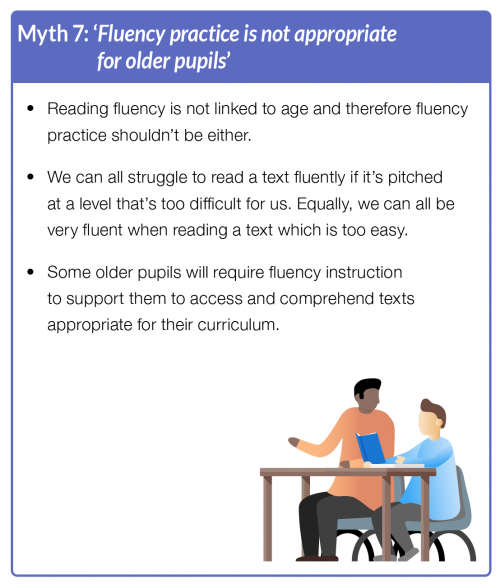
Reading fluency remains high on the education agenda. For many pupils who have jumped through the first statutory hoop of reading skill acquisition – the Phonics Screening Check – yet stumbled when tackling subsequent hoops - the KS1/KS2 reading SATs - a lack of fluency is often the barrier. But, what is meant by the term ‘reading fluency’? This segues neatly to the first resource produced in collaboration with the Education Endowment Foundation (EEF), published as part of their Improving Literacy in Key Stage 2 Guidance Report:
Reading Fluency Glossary: tool for supporting pupils to develop fluency reading capabilities
This single page document provides a succinct definition of ‘reading fluency’, alongside a brief outline of two core strategies proven to support pupils’ development: Guided Oral Reading and Repeated Reading. Its clarity and brevity make it an ideal tool to share with practitioners across the school to ensure agreed understanding of the key terminology used when discussing reading fluency.

The recognition of the importance of ‘repeated rereading’ is also highlighted in the recent Ofsted Curriculum research review series: English, published May 2022.
‘Repeated reading allows pupils to apply their knowledge to new material and is effective for a wide range of pupils from the early years onwards. The evidence reported in the review showed that repeated reading was effective for pupils with reading difficulties.'
Repeated reading is just one of a number of interrelated and highly effective strategies utilised to secure impressive progress for struggling readers on the HFL Education Reading Fluency Project. Teachers on the project note that when pupils read a text a specified number of times across the week, they developed proficiency, culminating in an ability to read the text with convincing expressiveness; in turn, the cognitive demand of simply word reading was reduced and pupils were able to focus energy and attention on the message that the text – read now with expert prosody – was giving them. By the time the pupils gathered for the second session of the week - the discussion session - they were buzzing with reflections and insights gleaned from the text, and most importantly, they were eager to share!
‘Magic Moments’ collected from participants on the spring 22 round of the HFL Education Reading Fluency Project
- a child said ‘I had no idea that you could get so much from a book’
- parents have asked what's changed in school because they can't wait to share their text with them at home
- the children enjoy reading now and one child was really keen to talk about and share a book they were reading at home
For many, reading fluency instruction has become an embedded part of their school’s pedagogical practice. Yet, how many schools have been able to invest the necessary time, energy and money to provide high-quality training ensuring that any adaptations to practice are underpinned by sound research and informed best practice? Having run the HFL Education Reading Fluency Project since 2018, we know just how much time and space is needed for teachers to not only adapt their practice, but to do so in an informed manner that transcends simply introducing a few quick fixes or dropping in a number of isolated strategies. When this is a case, progress of the most vulnerable readers is hampered and enthusiasm, both of teachers and pupils, quickly wanes. This leads us to the second resource produced in collaboration with the EEF:
Reading Fluency Misconceptions: misconceptions about what reading fluency is and is not
This double-page document outlines 8 common myths associated with reading fluency instruction. This tool will prove helpful for schools who feel they have implemented reading fluency practices but are struggling to see dramatic improvements for their pupils, especially their weakest readers. The document will support schools to reflect upon the strategies and approaches they are currently using and whether these are best placed to yield the results they need for their pupils.
Reading Fluency Misconceptions
‘I think the myths are really great 'interrupters' of what schools might have always done but not realised that some tweaks to their practice can make a huge difference to improving reading and comprehension via fluency’.
Alison Wood, KS3 HFL Education Reading Fluency Project Adviser

Disentangling the notion of fluent reading with fast reading has been an ongoing focus of the HFL Education Reading Fluency Project. Having worked with 1000s of pupils, we note that many struggling readers in KS2 and KS3 have quite a high reading rate at the start of the project; or, perhaps more accurately, their reading rate is erratic. Pupils often read super-fast for the first few sentences of the selected text and then when they hit a run of words they can decode with ease, then they fall into an excruciatingly slow pace as fatigue hits and decoding falters. Instead, through the project, we aim to support pupils to hone and refine a suitably paced internal reading voice that allows comprehension to flourish; this can alter throughout the text and be dependent upon a number of factors. Speed can be misleading as a measure for improved reading fluency; appropriate pace is crucial!
‘Magic Moments’ collected from participants on the Spring 22 round of the HFL Education Reading Fluency Project
- ‘(The pupils) Now pause at the right time instead of reading everything in one go!’
- ‘Children are paying attention to the punctuation when reading and are using it to break down larger sentences.’
- ‘Hearing them read beautifully with wonderful expression and seeing how far they've come makes you realise why we love this job so much!’

In recent years, our fluency focus has extended to working with KS3 practitioners and pupils. Far from finding the experience of engaging this older age group challenging, our project participants have reflected on how well KS3 pupils have responded to the project strategies:
‘We were not sure how this would work with older students, but with a very careful selection process, detailed discussions about pupil suitability with English teachers and the head of year, and as a result of using diagnostic reading tests (combined with my new found confidence in delivering the project) it was a success!’
Kelly Burke, second in department for English, Thomas Alleyne Academy, Stevenage.
Read more: HFL Education KS3 Reading Fluency Project: a practitioner’s perspective.
‘I could see it working with KS2 students but how would those on the edge of teenagerdom cope? …In reality, this was not an issue. The HFL Education team had recommended to just ‘go in’ with energy, pace and an expectation that everyone would join in and this really worked…they really loved the power of having a pencil and ‘text marking’ as we read’.
Catherine Root, Literacy Lead at Stationers' Crown Woods academy, Greenwich, southeast London.
Read more: HFL Education KS3 Reading Fluency Project: a practice-based review.
With pupils on the KS3 Reading Fluency Project making an average of 15 months progress in reading comprehension following the 8-week intervention, the evidence is clear that teaching reading fluency should not be seen as an age-limited intervention. In fact, the success we have seen with pupils in Years 7-9 has led us to explore the scope for a Key Stage 4 version of the HFL Education Reading Fluency Project. The HFL Education secondary specialists are well-underway with the development of this exciting project and will begin trials in autumn 2022 – watch this space!


